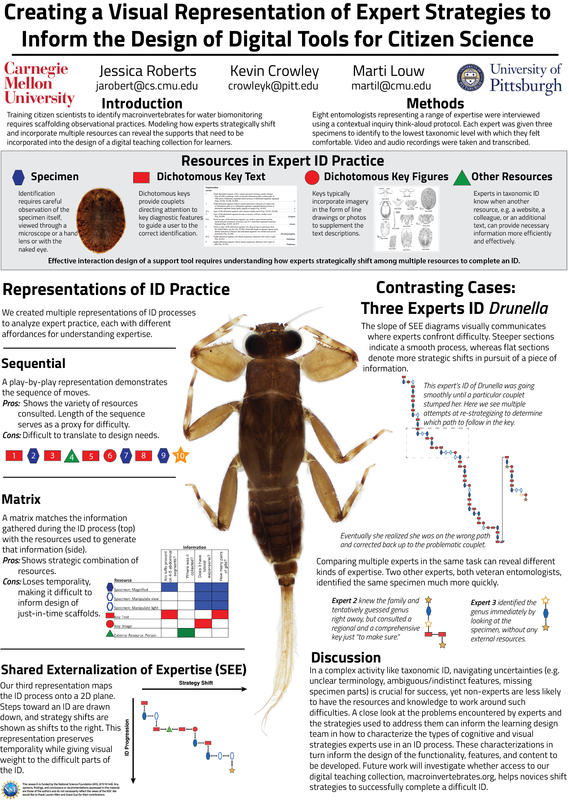|
by Jessica Roberts, Postdoctoral Research Fellow, Carnegie Mellon University In June I traveled to London for the International Conference of the Learning Sciences, this year presented as part of the London Festival of Learning, to present our work on the cognitive task analysis (CTA) studies conducted with eight entomology experts in Phase 1 of this project. Our subjects ranged in expertise from early career scientists to experienced citizen science trainers to professional entomologists with over 20 years of experience doing macroinvertebrate ID. We asked each expert to identify three specimens to the lowest taxonomic level they felt comfortable (typically genus), using whatever resources they had. Our analysis focused on strategy shifts: how did experts combine multiple kinds of knowing and observing in order to complete this task? While all the experts used at least one dichotomous key at some point, they rarely went step-by-step through all the couplets associated with a specimen in a single key. Instead, they used prior knowledge, informed colleagues, multiple keys, and even Internet searches to find the information they needed to move the identification forward in the most efficient and strategic way possible. They also knew how to look at the specimen -- whether at a particular angle, in a certain light, or with appropriate magnification -- to quickly see the features they needed to confirm an identification. Newcomers to taxonomic ID don't have access to the same variety of resources, nor do they necessarily know when a different resource or way of looking at a specimen will help them find the necessary information faster. Understanding experts' strategy shifts in identification can help us know what kinds of supports we need to build into our expanded version of our website as well as inform us when and where such supports need to be accessible to novice users. To convey this knowledge to our design team and various stakeholders, we created multiple representations of the expert task processes. The most fruitful representation is a diagram we call Shared Externalization of Expertise, or SEE, which maps moves toward an ID as steps down and strategic shifts as moves to the right. This spatial layout of the ID process helps us see where a particular tool or strategy is limited and identify the break points where a novice (without additional resources) might flounder. These SEE diagrams have helped us understand the design space and convey information challenges to our co-design partners. The poster presenting this work generated great discussions about how we can make sense of expert practices to design for learners who are not seeking to become full disciplinary experts but rather to develop "vernacular expertise" in order to be proficient citizen scientists. Roberts, J., Crowley, K., & Louw, M. (2018) Creating a Visual Representation of Expert Strategies to Inform the Design of Digital Tools for Citizen Science. In Proc. of the 13th International Conference of the Learning Sciences. London, UK.Comments are closed.
|
Project TeamAn interdisciplinary team Categories
All
Archives
June 2023
|


 RSS Feed
RSS Feed
